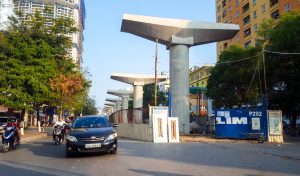Big plans are in motion to upgrade transport infrastructure throughout Vietnam. A first-of-its-kind metro line recently opened in Hanoi, and it appears to be gaining in popularity. Another pair of metro lines have been lumbering forward in Ho Chi Minh City, along with a mega-airport development in Long Thanh which will be accompanied by an extensive network of road and rail connections.
A long-mooted idea for a high-speed rail line running over 1,500 kilometers from north to south – at a cost of tens of billions of dollars – was also re-floated recently. This places Vietnam firmly in line with other countries in the region, such as Thailand, Indonesia, and the Philippines, which have been investing heavily in transport infrastructure. But in Vietnam lengthy delays have pushed many of these projects back by years, scrambling financing arrangements and begging the question: what is holding them up?
Let’s take the Ho Chi Minh City Metro Line 1, which has been funded mainly by the Japan International Cooperation Agency (JICA). The project is being overseen by the Management Authority for Urban Railways (MAUR), an agency under the HCMC government. In 2014, the government issued a report on the project estimating the first line would be operational by 2018. But the land acquisition has been extremely slow, and they sailed past that deadline. In a September 2020 newsletter, MAUR announced that only about 44 percent of the necessary land had been handed over. It appears now the line might be operational by 2023, but that could easily be pushed back.
Land acquisition has also severely delayed HCMC’s second metro line, a project that has been held back by administrative, technical, and land clearance bottlenecks for over a decade. This is complicating the project’s financing, as the original lenders, which include the Asian Development Bank and German state-owned lender KfW, have seen estimated costs nearly double. The government is now suggesting the line will not be in service until 2030.
Things are moving somewhat more smoothly at the new mega-airport project in Long Thanh, which is expected to handle tens of millions of passengers and relieve pressure on nearby Tan Son Nhat International Airport. With an overall price tag of around $16 billion, the airport is meant to anchor an extensive rail and road network in southern Vietnam and is considered a project of national strategic importance. It was reported in May 2022 that 90 percent of the land needed for the airport’s first phase had been handed over, and authorities expect the project to be operational by 2025. As with the metro projects, land acquisition has slowed things down but not quite as severely.
On the surface, this might seem a bit surprising. Vietnam is a one-party state with a highly centralized administrative structure. Technically, all land belongs collectively to the people, but is managed on their behalf by the state. A new land law passed in 2013 further enshrined the state’s ability to recover land for economic development purposes. So why has land acquisition caused massive delays in big public works projects?
For one thing, it is very common for planners and politicians to underestimate the complexity of big infrastructure programs, especially when they have limited experience with them. The government of Ho Chi Minh City has never built a metro line before, and MAUR, the agency tasked with carrying it out, is relatively new. On the other hand, the Airports Corporation of Vietnam, the state-owned airport operator, has been around for a while. So it’s not that surprising they are better at building airports than MAUR is at building metro lines.
But the bigger issue is that Vietnam’s land law needs work. Although it establishes the state’s right to acquire land for socio-economic development, the process remains opaque and hard to appeal. Compensation is not based on market pricing but is calculated by the state. The executive branch of government – at the national, provincial, or municipal level depending on the project – has most of the power to set the terms and decide the outcome of disputes. As a consequence, people are being offered less than the market value and the law does not provide a clear way to contest these outcomes.
When the land acquisition is carried out in such a manner it can go more slowly than if there are safeguards in place to ensure a minimum level of transparency (such as third-party appraisers) and establish legal mechanisms to appeal or contest the state’s will. If Vietnam wants to speed up the pace of some of these projects – and especially if this high-speed rail project has any shot at being built in our lifetime – taking a close look at the laws governing land acquisition would be a good place to start.

































